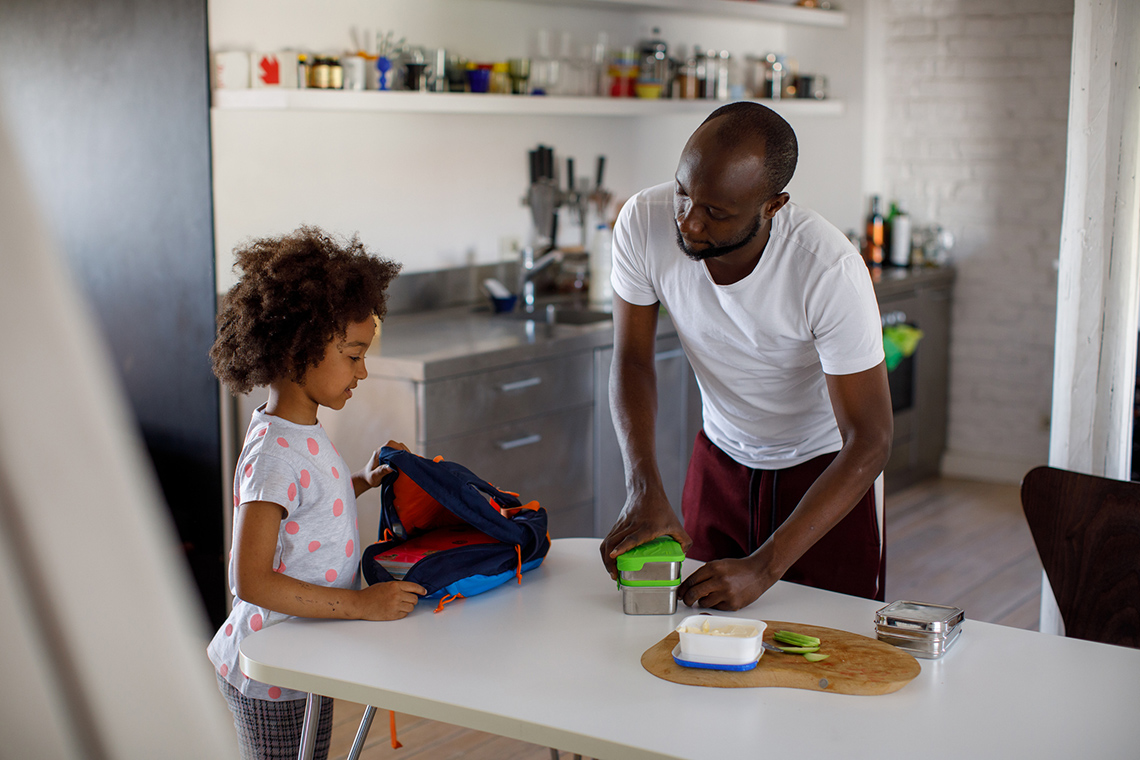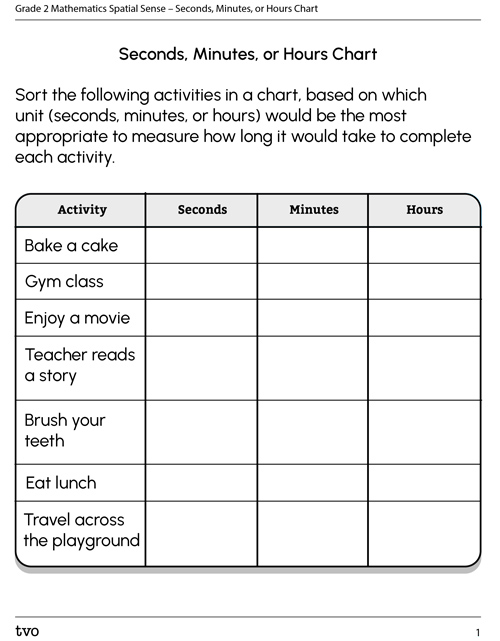Minds On
How long does it take?

Brainstorm
Let's think
Think about all the different things that happen in a day.
Some activities might happen really quickly, and others take longer to complete.
Brainstorm a list of activities that might take seconds, minutes, and hours to do.
Press ‘Show Me!’ to reveal an example.
Record your ideas in your notebook or another method of your choice.
Action
Parts of a clock
We can use a clock to help us keep track of how long it takes us to do something.
What are some parts of a clock?
Press on the following tabs to explore the parts of a clock.
The hands of the clock are:
- the second hand
- the longer minute hand
- the shorter hour hand
Exploring time
There are three standard units of time: seconds, minutes, and hours.
The clock helps us count the seconds, minutes, and hours.
Units of time
Press the following tabs to investigate the standard units of time.
- Seconds are the smallest unit of measurement on a clock.
- There are 60 seconds in a minute.
- Minutes are the next largest unit of time, and are measured using the minute hand.
- There are 60 minutes on a clock, and there are 60 minutes in an hour.
- Every time the minute hand moves that means on minute has passed.
Let’s explore the following example:

Recess Started

Recess Ended
There are two clock faces. The first clock shows the time that recess started (10:00 or ten o’clock). The shorter hour hand is at the 10 and the longer minute hand is pointing at the 12.
The second clock shows the time that recess ended (10:15 or ten fifteen). The shorter hour hand is just past the 10, and the longer minute hand is pointing at the 3.
This means that 15 minutes has passed since the start of recess.
- Hours are the largest unit of time, and are measured using the shorter hour hand.
- There are 60 minutes in an hour.
- When the minute hand travels all the way around the clock, that means one hour has passed.
Let’s explore the following example:

Math Class Started

Math Class Ended
There are two clock faces. The first clock shows the time when math class started (9:00 or nine o’clock). The short hour hand is at the 9, and the long minute hand is pointing at the 12.
The second clock shows the time when math class ended (10:00 or ten o’clock). The short hour hand is at 10, and the long minute hand is pointing at the 12.
This means that 1 hour has passed since math class started.
Clock clues
For each ‘Term,’ select the corresponding description.
Duration

Have you ever thought about how long it takes for you to get ready for school?
Does it take seconds, minutes, or hours?
When we think about how long something takes, another word we can use is duration.
When we are trying to figure out how long something takes or the duration, we explore the time it took from start to finish. We also consider the units we are using (seconds, minutes, or hours).
Seconds, minutes, or hours?

Sort the following activities in a chart, based on which unit (seconds, minutes, or hours) would be the most appropriate to measure how long it would take to complete each activity.
The activities to be sorted include:
- bake a cake
- gym class
- enjoy a movie
- teacher reads a story
- brush your teeth
- eat lunch
- travel across the playground
- enjoy a tv show
- bounce a ball once
- fill up a water bottle
- a school day
- an eraser falls off a desk
Complete the Seconds, Minutes, or Hours Chart in your notebook or using the following fillable and printable document. You can also use a method of your choice.

Press the Activity button to access the Seconds, Minutes, or Hours Chart.
Activity (Open PDF in a new tab)Press the following tabs to reveal a possible response for the Seconds, Minutes, or Hours Chart.
- bounce a ball once
- fill up a water bottle
- travel across the playground
- an eraser falls off a desk
- eat lunch
- enjoy a movie
- teacher reads a story
- brush your teeth
- a school day
- bake a cake
- gym class
- enjoy a movie
Consolidation
Your activities

Think of all the different things you do throughout the day.
- Pick 4 different tasks or activities and sort them by how much time they take to complete.
- Consider:
- Which task/activity takes the least amount of time?
- Which task/activity takes the greatest amount of time?
- Consider:
- Put them in order from least amount of time to greatest amount of time.
- Explain how you sorted the activities/tasks.
- Use seconds, minutes, and hours to describe each task.
Record your ideas in your notebook or another method of your choice.
Clocks and connections

Explore the following questions:
- What information does a clock tell you?
- Why is time important?
- What would happen if we did not pay attention to time?
Record your ideas in your notebook or another method of your choice.
Reflection
How do you feel about what you have learned in this activity? Which of the next four sentences best matches how you are feeling about your learning? Press the button that is beside this sentence.
I feel...
Now, record your ideas about your feelings using a voice recorder, speech-to-text, or writing tool.